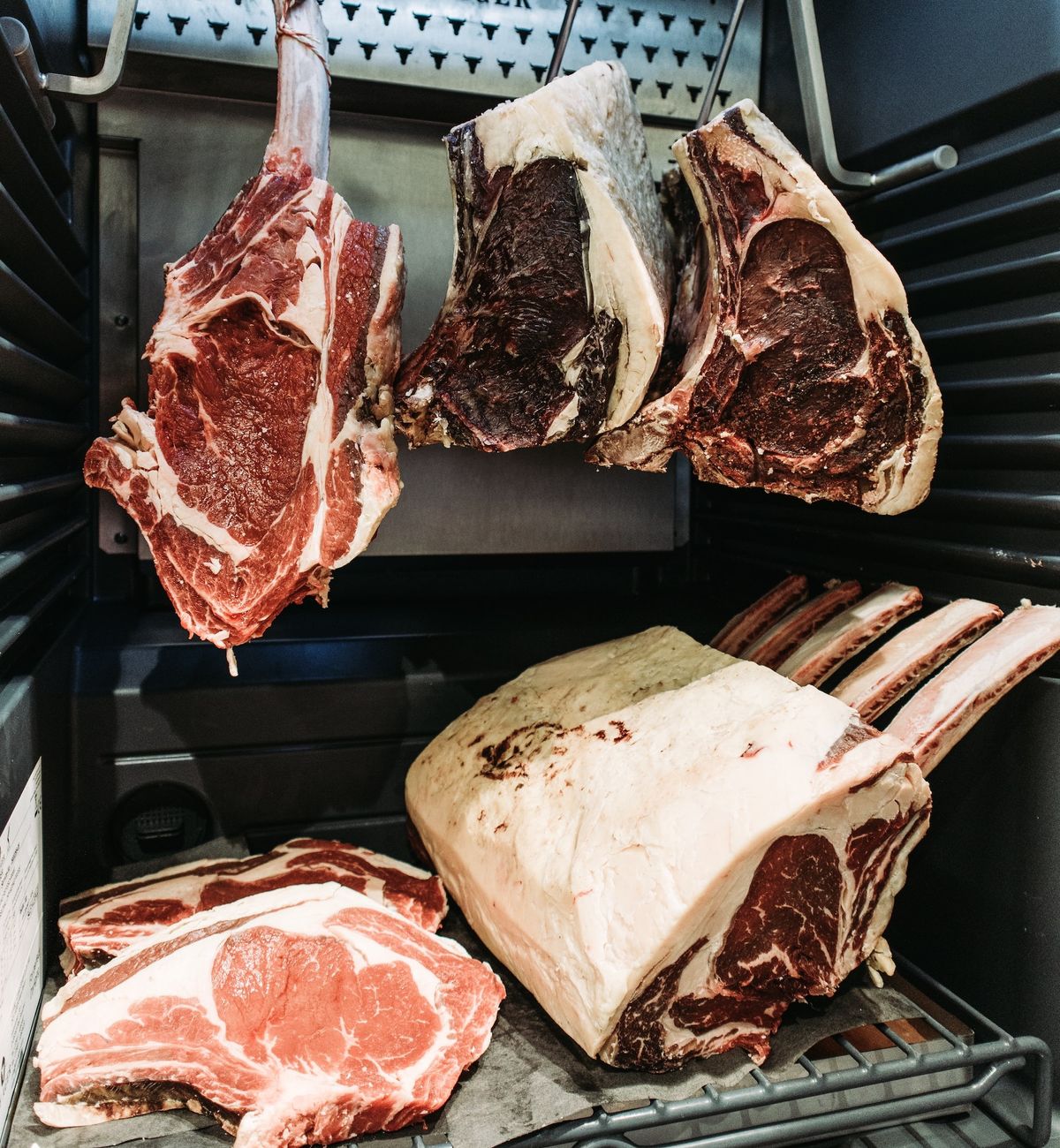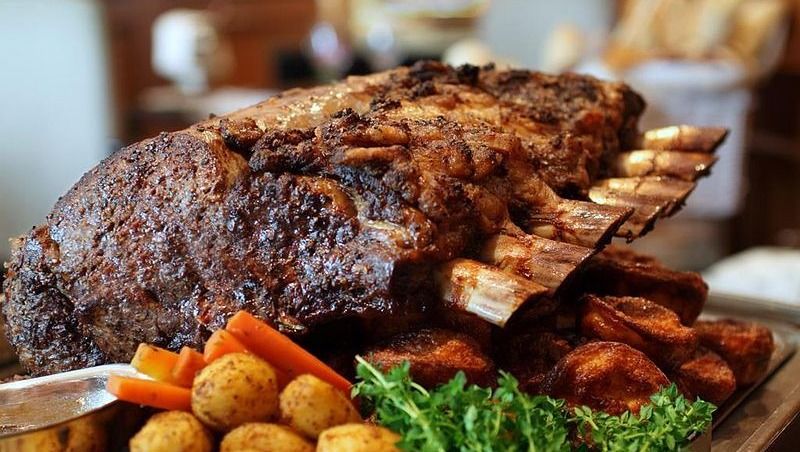Polmard Cote de Boeuf: World's Most Expensive Dry Aged Beef
Boucherie Polmard in Northeastern France presents a hibernation cuts, côte de bœuf, renowned as the world's priciest steak at $3,200. But what grants this rib steak its unparalleled worth?

What is Côte de boeuf?
Originating from France's rich culinary traditions, the côte de bœuf is a distinguished cut of beef that embodies the elegance of fine dining.
Renowned for its sumptuous marbling, it's essentially a prime rib steak or an American ribeye, distinguished by its attached bone which is only cost at $40 per pound.
This feature not only amplifies its flavor but also contributes to its melt-in-the-mouth tenderness. While it can be de-boned to present what the French refer to as ‘entrecôte’, the bone-in version remains a favorite for its depth of taste.
Polmard's Vintage Côte de boeuf
Nonetheless, the côte de bœuf from Boucherie Polmard in Northeastern France takes the distinction of this cut to unparalleled heights.
Priced at a staggering $3,200, their 2000 vintage cote de boeuf proudly holds the title of the world's priciest steak. One might wonder, what sets apart a rib steak from Boucherie Polmard to command such a significant value?
The Legacy
French butcher Alexandre Polmard stands as a beacon of unparalleled meat quality, representing the sixth generation of the illustrious Polmard family business, established in 1846.
Combining historical expertise with innovative dry-aging techniques, Alexandre continues to elevate the family's reputation, offering a tradition meets innovation beef experience that transcends mere dining.
This legacy, deeply rooted in passion and commitment, has positioned the Polmard Côte de Boeuf as a global benchmark in luxury meats.
Breed of Cattle for This Particular Steak
The Blonde d'Aquitaine cattle, competing with world-renowned beef or wagyu breeds like Black Angus and Kobe, are the pride of the Polmard family.
Nestled in the picturesque surroundings of Saint Mihiel in Lorraine's Meuse region, northeastern France, is where these cattle thrive.

Why Is Polmard Cote de Boeuf So Expensive?
Several factors contribute to the unparalleled value and premium pricing of this rib steak, elevating its status in the culinary world.
Rarity of Polmard Vintage Beef
The exceptional worth of Polmard beef lies in its sheer scarcity. As per Polmard's records, a mere 103 vintage beef ribs exist, spanning years from 1998 to 2009.
Their significant investment in advanced preservation techniques, notably the use of a specialized ventilated cold room set at negative temperatures, allows Polmard to maintain and offer some of the world's finest aged beef.
A single kilogram of Polmard's côte de bœuf from the 2000 vintage has fetched a staggering price of $3,200, making it the world's most expensive beef.
In an intriguing revelation, Polmard declined a jaw-dropping offer of more than $11,000 for an even more exclusive, aged cut, signifying that some treasures transcend monetary value.
Keeping Minimal Stress for Superior Meat Quality
Rather than keeping these cattle confined, the Polmard family believes in granting them freedom. Their cattle enjoy expansive forests and grasslands, experiencing nature firsthand.
When the weather turns unfavorable, the cattle have the option to retreat to dedicated shelters. For these animals, it's akin to living a five-star lifestyle.
Polmard believes in maintaining a personal connection with his cattle, engaging with them daily to ensure they lead relaxed, stress-free lives, even as their lifecycle comes to a close.
The estate stretches across an expansive 120 hectares and hosts just 300 cows. These cows roam freely, feasting on verdant grasslands.
However, in their last six months, they transition to a diet infused with a nutritious mix of cereals and grass, abundant in omega benefits.
Elevated stress in cows during their final moments results in a surge of glycogen and lactic acid, compromising the meat's tenderness and flavor.
Recognizing this, Polmard is channeling a significant investment, a million euros, into constructing a dedicated abattoir on his farm.
This facility will cater to a limited number of cows, only four per week, and is meticulously designed to maintain a calm environment, ensuring minimal stress for the animals.
Polmard's Exclusivity: Reserved for Culinary Maestros
Polmard's vintage beef, despite its premium price, has gastronomes and culinary enthusiasts booking months in advance for a taste of some of the world's most uniquely aged cuts.
Like wine, each beef vintage boasts its distinctive flavor and character.
Only a privileged few chefs globally receive the honor of presenting Polmard's unparalleled vintage beef to diners.
Before forging such partnerships, Polmard ensures a personal touch, visiting these culinary experts to emphasize the meat's distinct qualities.
Among the chefs, Fabrice Vulin of the esteemed two-Michelin-starred Caprice at Hong Kong’s Four Seasons Hotel stands out. Overlooking the mesmerizing Victoria Harbor, this epitome of French luxury is adorned with crystal and marble.
Special Preservation Method by Polmard's Family
Polmard's business carved a unique niche for itself in the 1990s when two pioneering figures, Polmard’s grandfather and father, embarked on a quest to refine meat preservation.
Their investigation culminated in the groundbreaking introduction of a method they termed “hibernation”.
This distinctive technique involves blasting meat with cold air traveling at speeds of 120 kilometers per hour within an icy environment of -43°C.
Remarkably, this method ensures that the meat can be preserved indefinitely without any degradation in its quality.
Polmard stands by the claim that there's absolutely no loss of quality, irrespective of how long the meat undergoes hibernation.
Typically, the beef they offer has been aged between 28 and 56 days, embodying the richness of flavor and texture that results from this innovative aging process.
How Does 2000 Vintage Beef Taste Like?
Polmard's vintage Côte de Boeuf presents a refined palate experience: lean, remarkably tender, and brimming with juiciness.
This exquisite beef, described by Alexandre as "silky and feminine steak" (reflecting the fact that all Polmard cattle are female), offers the quintessential steak flavor, but in a more elevated and nuanced form, where both texture and taste reach their pinnacle of perfection.
How Does the Meat Aging Process Work?
Upon an animal's slaughter, a transformative process kicks off. The meat's enzymes start softening muscle fibers, releasing the savory amino acid, glutamate - the heart of umami and the main element in MSG.
Simultaneously, the meat's fat oxidizes, and its muscle tissue loses water.
Where Polmard sets himself apart is in his mastery over these natural changes. By finely tuning the aging conditions, he dictates the exact tenderness and flavor profile of his meat.
A pioneering method from his father's playbook, akin to cryogenic freezing, is their secret weapon. This involves directing air chilled to a sharp -43°C at about 75 miles per hour continuously over the meat.
The distinction between Polmard's method and regular freezing? The distinction lies in the intricate details of how water crystallizes within the muscle fibers.
Polmard's technique offers a superior preservation and flavor-enhancing process compared to standard freezing, setting their beef in a league of its own.
Polmard's Vintage Steak: Worth the Price or Splurge?
The staggering price tag of a 2000 vintage rib steak from Polmard might leave many astounded at $3,200. However, its exclusive appeal is evident, given the months-long anticipation to secure a piece.
While in France, gourmet enthusiasts can relish this delicacy at a Polmard House restaurant. Alternatively, his boucherie in the Saint-Germain district offers a chance to procure this sought-after meat.
For those a tad hesitant about savoring a steak aged beyond a decade, Polmard doesn't disappoint, showcasing a range of meats aged between the more conventional 28 to 56 days.
Yet, when venturing into the realm of aged steaks, why not indulge in the best?


